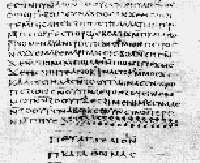Unpacking and publishing the Phaistos Disk since 1993
HOME | PREVIOUS | NEXT | SITEMAP
- In Sumer in Babylon. In the Babylonian creation epic of 4,500 BCE, dualism finds its first systematized expression. In this religion, Marduk battles Tiamat (Draco), also the dragon of the sea, an early depiction of the seven-headed hydra of the Gnostics and the Egyptians. In the Babylonian religion, Earth is considered the battleground between Good and Evil, as Marduk and Tiamat struggle for human souls. Marduk, the supreme Babylonian god, vanquishes Tiamat and the forces of chaos. The grateful gods construct for him Babylon and Esagila.
This religion greatly influenced the Jews, who were exiled in Babylon from 597-538 BCE. The dragon, Tiamat, becomes the serpent in Genesis who leads Adam and Eve to enlightenment, and to their Fall. In the Bible, when the serpent convinces Eve to eat of the fruit, and she convinces Adam to do the same, the serpent comes to be identified as Satan. God and Satan then begin their battle for human souls, with Earth as the battleground, just as Marduk and Tiamat had done before them. When the biblical Abraham left Ur at the age of 75 to establish the Hebrew nation in Canaan, he would have been very knowledgeable regarding this religion of dualism.
The great ziggurat at Ur was built by King Ur-nammu (2112-2095 BCE). This ziggurat is thought to be the inspiration behind the biblical story of the Tower of Babel. The chief deity of Ur was Nanna, the moon-god, to whom the king dedicated his oldest daughter as high priestess. According to the Greek historian Herodotus, the Chaldaean (Babylonian) god Nanna entered the ziggurat in person and took his rest upon the bed there. Much later, Berossos, a priest of Bel-Marduk, made Babylonian religion known to the Greeks. Other such priests followed after him, taking with them to Greece the stories of Marduk and Tiamat.
